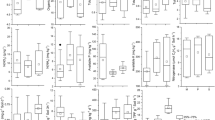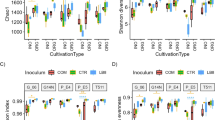Abstract
Cereal/cereal and cereal/legume intercropping systems are popular in the north, northwest, and southwest of China and often result in yield increases compared to monocropping. Rhizosphere interactions may play a significant role in the yield increases, particularly with respect to nutrient availability. The aim of this study was to investigate the effects of intercropping on N availability and community composition of ammonia-oxidizing bacteria in the rhizosphere of wheat, maize, and faba bean at different growth stages. Denaturing gradient gel electrophoresis (DGGE) based on 16S rRNA genes was used to analyze the community composition of bacterial ammonia oxidizers belonging to β-proteobacteria. The results showed that intercropping with faba bean significantly increased nitrate concentrations in the rhizosphere of wheat and maize at the second sampling time (20 June) compared to monocropping or intercropping between maize and wheat. Intercropping significantly affected the community composition of ammonia-oxidizing bacteria in the rhizosphere compared to monocropping, and the effects were most pronounced in the maize/faba bean and wheat/maize intercropping systems when faba bean and wheat were at anthesis and maize was in seedling stage. In wheat/faba bean intercropping, the effects of intercropping on community composition of ammonia-oxidizing bacteria were less pronounced at the seedling stage of the two species but were significant at anthesis.



Similar content being viewed by others
References
Alvey S, Yang CH, Buerkert A, Crowley DE (2003) Cereal/legume rotation effects on rhizosphere bacterial community structure in West African soils. Biol Fertil Soils 37:73–82
Bruns MA, Stephen JR, Kowalchuk GA, Prosser JI, Paul EA (1999) Comparative diversity of ammonia-oxidizer 16S rRNA gene sequences in native, tilled, and successional soil. Appl Environ Microbiol 65:2994–3000
Carelli M, Gnocchi S, Fancelli S, Mengoni A, Paffetti D, Scotti C, Bazzicalupo M (2000) Genetic diversity and dynamics of Sinorhizobium meliloti populations nodulating different alfalfa cultivars in Italian soils. Appl Environ Microbiol 66:4785–4789
Chowdhury MK, Rosario EL (1994) Comparison of nitrogen, phosphorus and potassium utilization efficiency in maize/mungbean intercropping. J Agri Sci 122:193–199
de Ridder-Duine AS, Kowalchuk GA, Klein Gunnewiek PJA, Smant W, Van Veen JA, De Boer W (2005) Rhizosphere bacterial community composition in natural stands of Carex avenaria (sand sedge) is determined by bulk soil community composition. Soil Biol Biochem 37:349–357
Donald CM (1985) The interaction of competition for light and for nutrients. Aust J Agr Res 9:421–435
Fiona L, Jordan J, Jason L, Cantera EF, Lisa YS (2005) Autotrophic ammonia-oxidizing bacteria contribute minimally to nitrification in a nitrogen-impacted forested ecosystem. Appl Environ Microbiol 71:197–206
Kowalchuk GA, Stephen JR, De Boer W, Prosser JL, Embley TM, Woldendorp JW (1997) Analysis of β-proteobacteria ammonia-oxidising bacteria in coastal sand dunes using denaturing gradient gel electrophoresis and sequencing of PCR amplified 16S rDNA fragments. Appl Environ Microbiol 63:1489–1497
Leininger S, Urich T, Schloeter M, Schwark L, Qi J, Nicol GW, Prosser JI, Schuster SC, Schleper C (2006) Archaea predominate among ammonia-oxidizing prokaryotes in soils. Nature 442:806–809
Li L, Sun JH, Zhang FS, Li XL, Yang SC, Rengel Z (2001) Wheat/maize or wheat/faba bean strip intercropping. I. Yield advantage and interspecific interaction on nutrients. Field Crops Res 71:123–137
Li L, Tang C, Rengel Z, Zhang FS (2003a) Chickpea facilitates phosphorus uptake by intercropping wheat from an organic phosphorus source. Plant Soil 248:305–312
Li L, Zhang FS, Li XL, Christie P, Sun JH, Yang SC, Tang C (2003b) Interspecific facilitation of nutrient uptake by intercropped maize and faba bean. Nutr Cycl Agroecosyst 65:61–71
Liesack W, Weyland H, Stackebrandt E (1991) Potential risks of gene amplification by PCR as determined by 16S rDNA analysis of a mixed-culture of strict barophilic bacteria. Microb Ecol 21:191–198
Marschner P, Neumann G, Kania A, Weiskopf L, Lieberei R (2002) Spatial and temporal dynamics of the microbial community structure in the rhizosphere of cluster roots of white lupin (Lupinus albus L.). Plant Soil 246:167–174
McCaig AE, Phillips CJ, Stephen JR, Kowalchuk GA, Harvey SM, Herbert RA, Embley TM, Prosser JI (1999) Nitrogen cycling and community structure of proteobacterial β-subgroup ammonia-oxidizing bacteria within polluted marine fish farm sediments. Appl Environ Microbiol 65:213–220
Phillips CJ, Smith Z, Embley TM, Prosser JI (1999) Phylogenetic differences between particle-associated and planktonic β-proteobacteria ammonia-oxidizing bacteria in the northwestern Mediterranean Sea. Appl Environ Microbiol 65:779–786
Phillips CJ, Harris D, Dollhopf SL, Gross KL, Prosser JI, Paul EA (2000) Effects of agronomic treatments on structure and function of ammonia-oxidizing communities. Appl Environ Microbiol 66:5410–5418
Robertson GP (1982) Factors regulating nitrification in primary and secondary succession. Ecology 63:1561–1573
Shackle KA, Hall AE (1984) Effect of intercropping on the water relations of sorghum and cowpea. Field Crops Res 8:381–387
Smalla K, Wieland G, Buchner A, Zock A, Parzy J, Kaiser S, Roskot N, Heuer H, Berg G (2001) Bulk and rhizosphere soil bacterial communities studied by denaturing gradient gel electrophoresis: plant-dependent enrichment and seasonal shifts revealed. Appl Environ Microbiol 67:4742–4751
Snaydon RW, Harris PM (1981) Interaction below ground—the use of nutrients and water. In: Proceedings of international workshop on intercropping, ICRISAT, Hyderabad, pp 188–201
Song YN, Zhang FS, Marschner P, Fan FL, Bao XG, Sun JH, Guo TW, Li L (2007) Effect of intercropping on crop yield and chemical and microbiological properties in rhizosphere of wheat (Triticum aestivum L.), maize (Zea mays L.) and faba bean (Vicia faba L.). Biol Fertil Soils. DOI 10.1007/s00374-006-0139-9
Stephen JR, McCaig AE, Smith Z, Prosser JI, Embley TM (1996) Molecular diversity of soil and marine 16S rRNA gene sequences related to β-subgroup ammonia-oxidizing bacteria. Appl Environ Microbiol 62:4147–4154
Stephen JR, Kowalchuk GA, Bruns MA, McCaig AE, Phillps CJ, Embley TM, Prosser JI (1998) Analysis of β-subgroup proteobacteria ammonia-oxidizer populations in soil by denaturing gradient gel electrophoresis analysis and hierarchical phylogenetic probing. Appl Environ Microbiol 64:2958–2965
Woese CR, Weisburg WG, Paster BJ, Hahn CM, Tanner RS, Kreig NR, Koops HP, Harms H, Stackebrandt E (1984) The phylogeny of the purple bacteria: the beta subdivision. Syst Appl Microbiol 5:327–336
Woese CR, Weisburg Hahn CM, WG, Paster BJ, Zablen LB, Lewis BJ, Mackie TJ, Ludwig W, Stackebrandt E (1985) The phylogeny of the purple bacteria: the gamma subdivision. Syst Appl Microbiol 6:25–33
Zhang FS, Li L (2003) Using competitive and facilitative interactions in intercropping system to enhance crop productivity and nutrient-use efficiency. Plant Soil 248:305–312
Acknowledgements
The research was supported by the National Natural Sciences Foundation of China (Project number 30571104), by the Major State Basic Resource Development (973) Program of the People’s Republic of China (Project number 2006CB100206), and by the Program for Changjiang Scholars and Innovative Research Team in University (Project no. IRT0511).
Author information
Authors and Affiliations
Corresponding author
Rights and permissions
About this article
Cite this article
Song, Y.N., Marschner, P., Li, L. et al. Community composition of ammonia-oxidizing bacteria in the rhizosphere of intercropped wheat (Triticum aestivum L.), maize (Zea mays L.), and faba bean (Vicia faba L.). Biol Fertil Soils 44, 307–314 (2007). https://doi.org/10.1007/s00374-007-0205-y
Received:
Revised:
Accepted:
Published:
Issue Date:
DOI: https://doi.org/10.1007/s00374-007-0205-y




